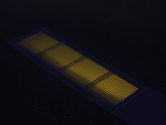John Hurrell – 23 March, 2021
The whole room is dominated by an eerie violet light that radiates from the large film-covered window on the lefthand side, penetrating through the horizontal slivers of a Venetian blind to be reflected in the glass of the lined-up photographs. On the floor and walls of the far righthand corner Lamont has placed two televisions showing a treatment of lurching bleached blobs in a blurred pink room. There are also five ventilation grilles on the floor that emit an ominous dark-lemony glow, and four spots lighting up the bottom half of two walls.
Auckland
Steve Carr and Christian Lamont
Fading to the Sky
27 February - 30 May 2021
In this collaborative meditation on grief and death, Steve Carr presents a suite of 23 photographs and two videos, merging with an in situ light installation by Christian Lamont—both artists taking advantage of the unusually shaped, top floor, Te Uru gallery.
Understandably distressed by the recent death of his mother, Carr has his wife photograph him in bed, sitting up (deep in thought), and pressing an apple against various parts of his upper body where most of the time he cannot see it. (He it seems was ‘the apple of his mother’s eye,’ and she his.)
With his photographs, Carr presents two videos: Winter Feeding (2020), a sequence of revolving shots of white towers of dripping (birdfood his mother used to organise) as it has been devoured by hungry avians—we notice its constantly changing and diminishing shape—and American Night (2014), a tribute to David Lynch (his Blue Velvet and Twin Peaks intros) with a mechanical bird briefly singing in a Cherry Blossom tree, and the dawn light gradually emerging and then (after noon) darkening from dusk to embrace blue night (a metaphor for the brevity of life).
The whole room is dominated by an eerie violet light that radiates from the large film-covered window on the lefthand side, penetrating through the horizontal slivers of a Venetian blind to be reflected in the glass of the lined-up photographs. On the floor and walls of the far righthand corner Lamont has placed two televisions showing a treatment (400 Lux) of lurching bleached blobs in what appears to be a blurred pink room. There are also five ventilation grilles on the floor that emit an ominous dark-lemony glow, and four ceiling spots casting a warm diffuse light on the bottom half of the two walls displaying the photographs.
This exhibition has an emotionally charged ambience that is visually and linguistically induced, but it also has an unintended audio component due to Te Uru’s problems with sound leakage in the architecture, specifically the haunting (but here distracting) voices of Te Awhina Kaiwai-Wanikau and Waimarama Tapiata Bright in Shannon Te Ao’s video work (Kare ana, taapapa ana) on the floor below.
Some might argue that this coincidence is a bonus, but I doubt whether Carr and Lamont factored it in, especially as Te Ao’s show opened a week after theirs. Both shows are terrific (and headphones would spoil Te Ao’s project) but they should have been kept chronologically apart.
Carr and Lamont are a great team, in this installation demonstrating impressive simpatico. It’s a classy—emotionally powerful—presentation.
John Hurrell
















 Advertising in this column
Advertising in this column Two Rooms presents a program of residencies and projects
Two Rooms presents a program of residencies and projects



This Discussion has 0 comments.
Comment
Participate
Register to Participate.
Sign in
Sign in to an existing account.